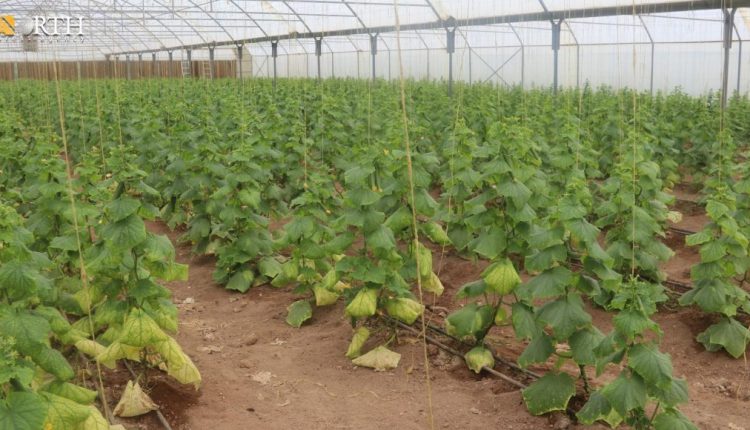HASAKAH, Syria (North Press) – Ahmad Taha, a merchant, stands in front of his shop in the vegetable market in Hasakah Governorate, northeastern Syria. He expresses concerns about the soaring prices of vegetables amidst the deteriorating economic situation.
“May God help the people,” Taha says.
Local markets witness a significant increase in vegetable prices, impacting the purchasing power of residents amidst the continuous devaluation of the Syrian pound against foreign currencies.
Reasons for high prices
Taha attributes the rise in vegetable prices to the high costs of materials used by the farmers in addition to the increased shipping fees from outside Hasakah or abroad due to the expensive fuel.
“The high prices directly affect consumers, and the merchants also make little profits”, Taha says.
According to traders, vegetables and fruits are imported into areas run by the Autonomous Administration of North and East Syria (AANES) through the Kurdistan Region of Iraq (KRI) as well as from Syrian opposition-controlled areas in northwestern Syria and government-held areas.
They stress that shipping costs amount to around $400 for domestic shipments within Syria, while they are even higher for goods imported from abroad.
“Vegetable prices have soared, especially staples like tomatoes, cucumbers, peppers and others, in addition to fruits,” Taha comments.
A kilogram of tomatoes is sold at 9,000 Syrian pounds (SYP which equals about $0.60), cucumbers at 10,000 SYP (about $0.66), zucchinis at 11,000 SYP (about $0.73), and potatoes at 7,500 SYP (about $0.50), according to local vendors in Hasakah.
Market demand
Over the past years, the AANES has worked to open three greenhouse projects in Northeast Syria to ease the pressure of high prices on the population. The projects also aim to secure various types of locally produced vegetables and limit monopoly by traders.
The AANES seeks to apply this greenhouse experiment across areas under its administration. However, the high costs of cultivation in greenhouses have hindered development efforts, leading farmers to rely on low greenhouse tunnels, where farmers start cultivation in mid-February and harvest in early May within limited areas due to rising irrigation costs in recent years.
Bassel Muhammad, co-chair of the Union of Cooperative Associations affiliated with the AANES in Hasakah, states that they established several greenhouse projects. “Currently, we try to expand our projects and get support to secure the population’s needs of vegetables at reasonable prices,” Muhammad states.
Hasakah is known for the cultivation of vegetable during Summer, but winter projects are scarce due to the cold weather. “Therefore, we are forced to import goods from abroad at high prices,” Muhammad says.
Muhammad told North Press that the vegetables produced from these projects now cover about 15 percent of the local market’s demand compared to the low success achieved last year.
As for supporting similar projects, Muhammad says, “We plan to expand these projects in the coming period. However, greenhouses are very costly in Winter. Therefore, we have resorted to low greenhouse tunnels, which cost less.”
The Union of Cooperative Associations plans to establish a community market where products of small projects are sold to citizens at lower prices. Muhammad points out that traders add costs of shipment and other expenses to the price of imported vegetables. They, however, can monitor and determine the costs.
Greenhouses
The Union of Cooperative Associations established a greenhouse project two years ago in the town of Tweinah in the northwest of Hasakah. The project, covering an area of 3,705 acres, is cultivated with cucumbers and tomatoes and is located near the Washokani camp for the IDPs of the city of Sere Kaniye (Ras al-Ain).
The project includes 28 greenhouses and provides job opportunities for three families. The goal of the project is to secure a portion of the local market’s demand at competitive prices.
Berivan Reshk, an agricultural engineer supervising the project, says, “Each greenhouse produces around 16 tons of cucumbers and approximately eight tons of tomatoes during Summer. However, the production lessens in Winter due to the cold weather and the limited available resources.”
Reshk points out that they began marketing the products about a month ago after starting cultivation in November 2023.
Reshk told North Press, “We sell a portion of our products to one of the AANES’s cooperative associations in Hasakah, whereas the bigger portion of the products are sold in the local market.”
The prices of the products are cheaper than the imported ones. “For instance, a kilogram of cucumbers is sold in the markets for 10,000 SYP, but we sell it for 8,000 SYP,” adding they aim to ease the burden on the people,” she says.

